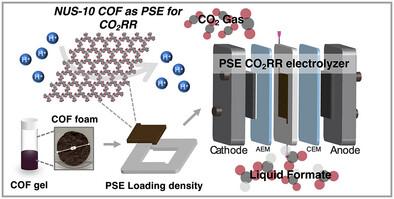共价有机骨架作为多孔固体电解质用于电化学CO2还原
IF 19
1区 材料科学
Q1 CHEMISTRY, MULTIDISCIPLINARY
引用次数: 0
摘要
二氧化碳(CO2RR)的电化学还原为高价值的化学物质提供了一种有前途的方法来存储可再生能源,同时有助于关闭人为碳循环。多孔固体电解质(PSE)的使用使CO2RR更具可持续性,因为它们是可回收的,并且可以生产不含电解质污染物的纯液体产品。然而,目前的pse存在离子传导不足和可扩展性差等局限性。在这里,磺化的NUS-10共价有机框架(COF)泡沫被证明是高效CO2RR的pse,能够产生有价值的产品,包括甲酸、一氧化碳和C2+化合物。概述了一种简单、可扩展的微波辅助合成方法,用于生产NUS-10 COF纳米片,该纳米片可以冷冻干燥以制造NUS-10质子交换泡沫。这些泡沫具有很高的质子导电性(在30°C时σ = 0.052 S cm - 1),并且可以在多个设备操作中轻松回收而没有质量损失。当应用于PSE CO2RR电解槽时,NUS-10 COF表现出卓越的电化学效率,在200 mA cm - 2电流密度下,需要低于4 V的电池电压才能产生高纯度甲酸。本研究推进了CO2RR的COF PSE的发展,为CO2RR的可持续和实际应用提供了一条途径。本文章由计算机程序翻译,如有差异,请以英文原文为准。

Covalent Organic Frameworks as Porous Solid Electrolytes for Electrochemical CO2 Reduction
The electrochemical reduction of carbon dioxide (CO2RR) to high-value chemicals offers a promising approach to storing renewable energy while helping to close the anthropogenic carbon loop. The use of porous solid electrolytes (PSE) makes CO2RR more sustainable because they are recyclable and can produce pure liquid products free of electrolyte contaminants. However, current PSEs have several limitations including insufficient ion conduction and poor scalability. Here, sulfonated NUS-10 covalent organic framework (COF) foams are demonstrated as PSEs for efficient CO2RR capable of producing valuable products including formic acid, carbon monoxide, and C2+ compounds. A straightforward, scalable microwave-assisted synthesis method is outlined for producing NUS-10 COF nanosheets, which can be freeze-dried to create NUS-10 proton exchange foams. These foams exhibit high proton conductivity (σ = 0.052 S cm−1 at 30 °C) and can be easily recycled without mass loss across multiple device operations. When applied in PSE CO2RR electrolyzers, NUS-10 COF exhibites exceptional electrochemical efficiency, requiring less than 4 V of cell voltage at 200 mA cm−2 current density to produce high-purity formic acid. This study advances the development of COF PSE for CO2RR, offering a path toward more sustainable and practical applications of CO2RR.
求助全文
通过发布文献求助,成功后即可免费获取论文全文。
去求助
来源期刊

Advanced Functional Materials
工程技术-材料科学:综合
CiteScore
29.50
自引率
4.20%
发文量
2086
审稿时长
2.1 months
期刊介绍:
Firmly established as a top-tier materials science journal, Advanced Functional Materials reports breakthrough research in all aspects of materials science, including nanotechnology, chemistry, physics, and biology every week.
Advanced Functional Materials is known for its rapid and fair peer review, quality content, and high impact, making it the first choice of the international materials science community.
 求助内容:
求助内容: 应助结果提醒方式:
应助结果提醒方式:


